- Size
- Smallest
- Small
- Small to Medium
- Medium
- Large
- Giant
- Characteristics
- Smartest
- Hypoallergenic
- Fluffy
- Best Guard
- Best Family
- Best for Kids
- Low Shedding
- Healthiest
- Police Dogs
- Most Calm
- Quietest
- Color
- White
- Black
- Grey
- Brown
- Blue
- Red
- Coat
- Hairless
- Short
- Long
- Origin
- Japan
- China
- Australia
- Germany
- Italy
- United States
- France
- Group
- Hound
- Terrier
- Herding
- Toy
- Working
- Sporting
Doberman vs. Rottweiler: Which Is the Better Guard Dog?
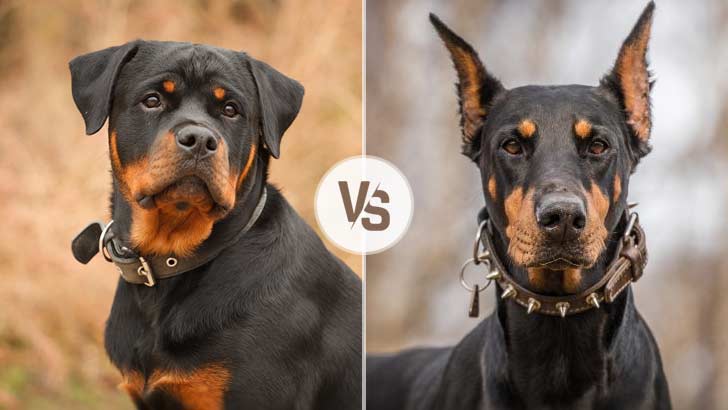
There are a few things that help prevent crime from reaching someone's home. A guard dog or dog in the home is one proven deterrent for criminals.
There is a list of dogs that make natural guard dogs and among those are two breeds that hail from Germany: the Rottweiler and the Doberman Pinscher.
Even though the two dogs have similar appearances, they have different temperaments and have required different types of care.
So if you need to know which is better, the Doberman or the Rottweiler, then read on!
- 1. Doberman Pinscher Pros and Cons
- 2. Rottweiler Pros and Cons
- 3. How to Choose
- 4. Final Verdict
Doberman Pinscher
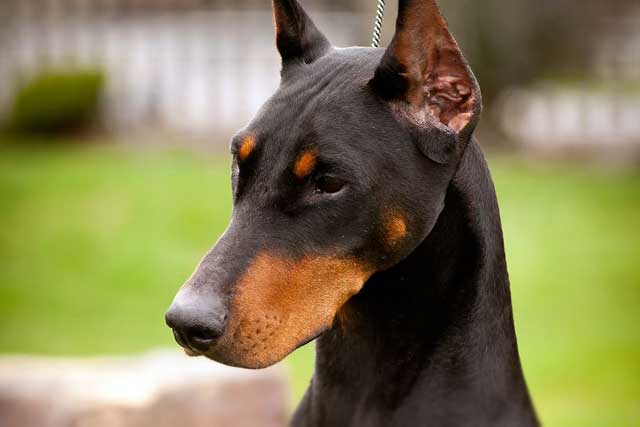
The Doberman Pinscher is a working dog also developed in Germany. The Doberman was developed by mixing a variety of dogs from the Rottweiler and the Black and Tan Pinscher. This dog was developed in the 19th century by Karl Friedrich Louis Dobermann who was a tax collector in Germany. He developed the breed to provide him with protection.
Dobermans, also known as Dobies, traditionally have their tails docked shortly after birth. They also have their ears cropped. Dobermans have naturally floppy ears. They come in a variety of colors including black and tan (most common), red and tan, blue and tan, and fawn and tan. White Dobies do exist, although they are not accepted by dog shows.
The typical lifespan of a Dobie is 9-12 years and the males are larger than the females. Males typically weigh 88-99 lbs and females weigh 71-77 lbs. The Dobie is a tall and muscular dog that has a lean appearance.
Doberman Pinscher Pros
- Dobies are very intelligent dogs that take quickly to training and learning and are very responsive to their owners. It ranks as one of the highest breeds in terms of obedience intelligence.
- The temperament of a Doberman is protective, loyal, hard-working, intelligent, and fearless. They develop strong bonds with their owners, so close that many can develop separation anxiety.
- Dobermans should be protective, but not aggressive. Working and European lines tend to be more protective than those bred in North America for show lines.
Doberman Pinscher Cons
- The amount of exercise needed by Dobermans is one of their biggest drawbacks. They need the intense exercise of at least two hours a day or they will become bored. Dobermans are highly social and need to be included in family events and can develop separation anxiety; some of this is because they tend to be a one-person dog.
- Dobermans are lean dogs that have muscle, but because they are lean they cannot withstand cold temperatures. They are sensitive to hot temperatures as well. In general, Dobermans tend to be more sensitive dogs and cannot handle rough training.
- Many Dobermans have a high prey drive and will chase smaller animals such as cats and even small dogs. Dogs from certain lines tend to be timider making potential aggression a problem.
Rottweiler

The Rottweiler is a large size dog that has the colors of black and tan or black and mahogany. The Rottweiler was developed in Germany to haul carts full of meat to the market and were also used to herd sheep.
Most Rottweiler, or Rotties as they are affectionately known, have their tails docked shortly after birth. The Rottie has a naturally long tail. The average male weighs 110-132 lbs and the female is smaller at 77-106 lbs. The average lifespan of a Rottie is 8-10 years.
Rottweiler Pros
Rotties are highly intelligent dogs and require both physical and mental stimulation.
- Rotties have easy to care for short coats.
- Rotties tend to have a strong muscled or barreled chest.
- Rottweilers are intelligent dogs that pick up commands quickly and are very responsive to training.
Rottweiler Cons
The temperament of a Rottie is, of course, that of a guard dog. A common misconception is that these dogs are aggressive, however, there is a difference between protectiveness vs. aggression. A Rottie is naturally a calm but courageous dog that is fairly aloof with people he or she does not know.
- If these dogs are not exercised or challenged he or she can develop destructive tendencies.
- Potential Rottie owners should be aware that many of these dogs can have high prey drives which makes them unsuitable for living with small animals such as cats or small dogs.
- Rotties can get along with children, but it is recommended that the household have children age five and over as Rotties can be boisterous (especially when young) and can easily knock over a young child.
- Rottweilers do require someone willing to commit time to exercise and these dogs do best with an hour or more of intense exercise including jogging, hiking, or walking with a backpack designed for dogs.
How to Choose
What is the Difference Between the Two Breeds?
One of the biggest differences is what the dogs were bred for. The Rottie was originally bred to pull carts of meat and herd sheep. The Doberman was bred to be a protector. There are differences in temperament with the Rottie tending to be calmer and less territorial than the Doberman. Dobermans tend to be more vigilant and alert.
Rotties can fit in well with a family and bond to more than one person, whilst Dobermans tend to bond closely with one person. Dobermans are more athletic than Rotties and need quite a bit more exercise.
Which is the Better Guard Dog?
This depends on what factors a potential owner is looking for in a guard dog. If the owner is considering the overall lifespan of the breed, then Dobermans tend to live longer than Rotties. Dobermans were also specifically bred as working dogs for protection.
Dobermans are athletic and require mental and physical stimulation, so the owner should be able to devote 1-2 hours of heavier exercise such as jogging. Dobermans do take time to mature and will not be ready for protection training until about two years of age. Dobermans tend to more alert and vigilant then Rotties
The Rottie is robust and has a more intimidating appearance than the Doberman, too many people. They are also easier to exercise and can be content with forty-five minutes of exercise. Rotties can fit into a family with younger children and tends to be more gentle than the Doberman.
Rotties tend to be more playful and have a silly side. Rotties can bond with multiple people, while Dobermans tend to be a one-person dog. Rotties do slightly better in adapting to varying climates because of their muscular build vs. the Dobermans slimmer build (and less fat for protection).
Final Verdict
Which one should a potential owner choose?
First of all, these dogs require an owner who can be assertive. Either dog left untrained has the potential to become a liability.
That being said, if the owner is looking for a dog that bonds most closely to one person than a Doberman is probably the better choice.
Rottweilers tend to be more docile and less territorial than Dobermans, which makes them a better choice for families.
References
- [1] ^ YouTube video: Dog Breed Comparison: Doberman vs Rottweiler
- [2] ^ Love Your Dog: Doberman Pinscher vs. Rottweiler: Breed Differences & Similarities
You May Also Like
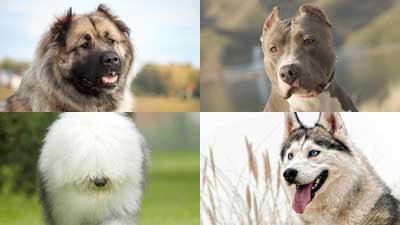 Help & AdviceThese 10 Dog Breeds Novice The Best Not To Keep!
Help & AdviceThese 10 Dog Breeds Novice The Best Not To Keep!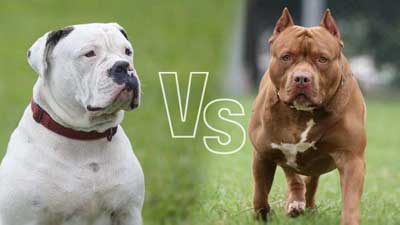 Breed ComparisonAmerican Bulldog vs. Pit Bull: Which is Stronger?
Breed ComparisonAmerican Bulldog vs. Pit Bull: Which is Stronger?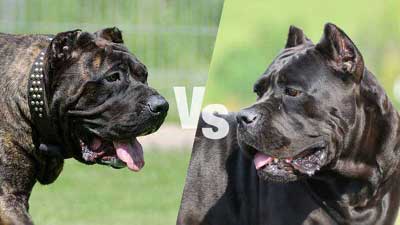 Breed ComparisonPresa Canario vs. Cane Corso: Which Is the Better Guard Dog?
Breed ComparisonPresa Canario vs. Cane Corso: Which Is the Better Guard Dog?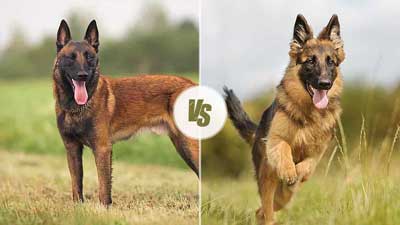 Breed ComparisonBelgian Malinois vs. German Shepherd: Which Is Better?
Breed ComparisonBelgian Malinois vs. German Shepherd: Which Is Better?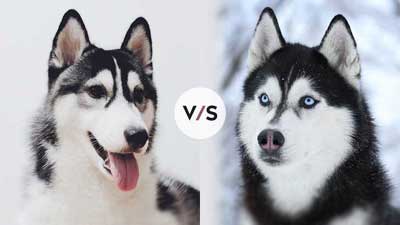 Breed ComparisonAlaskan Husky vs. Siberian Husky: Which Is Better?
Breed ComparisonAlaskan Husky vs. Siberian Husky: Which Is Better?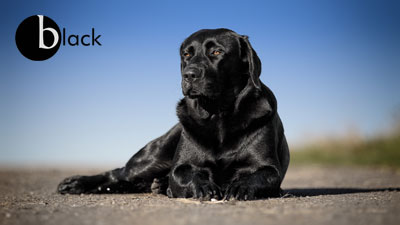 Breed Reviews10 Most Common Black Dog Breeds
Breed Reviews10 Most Common Black Dog Breeds